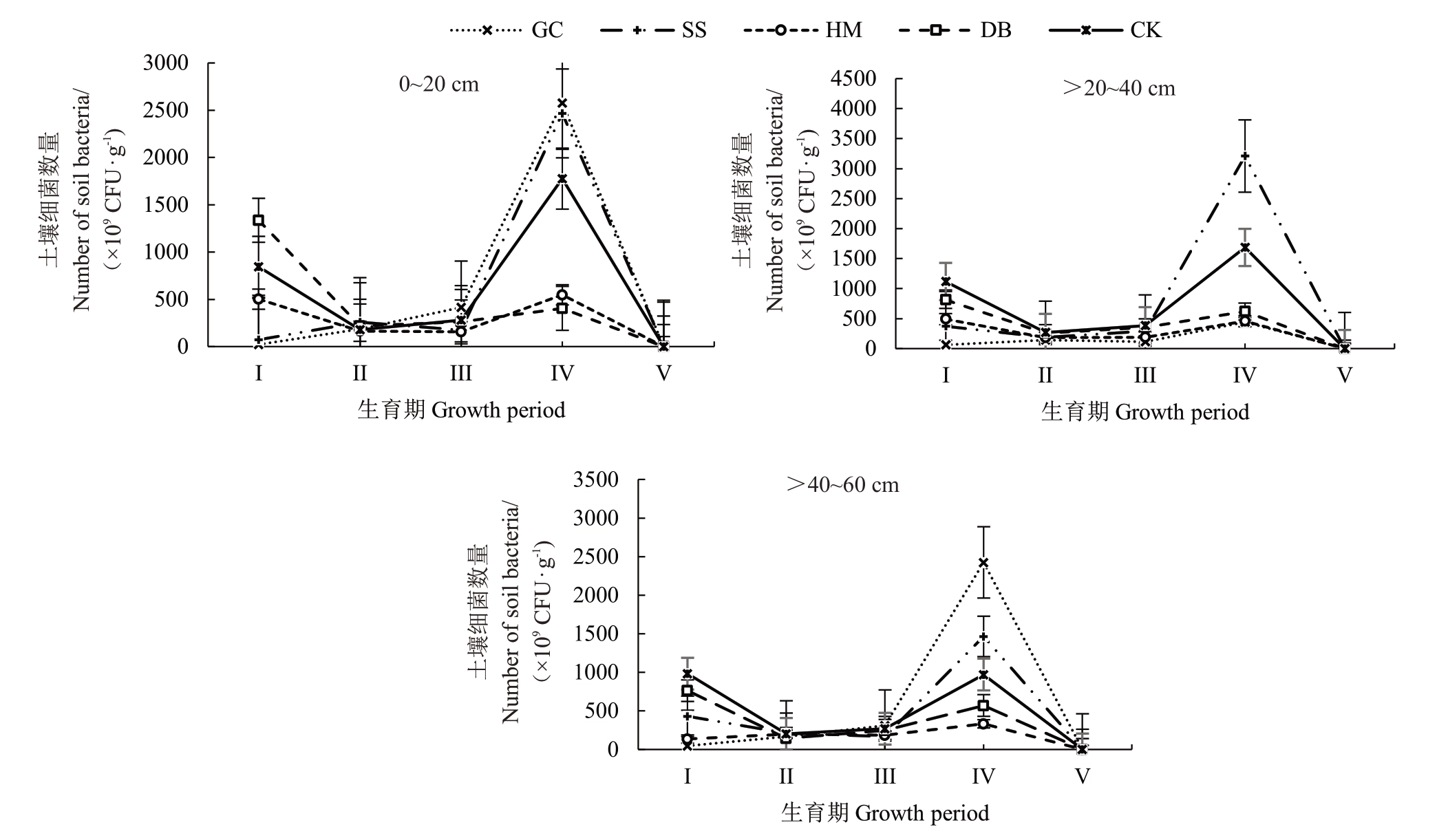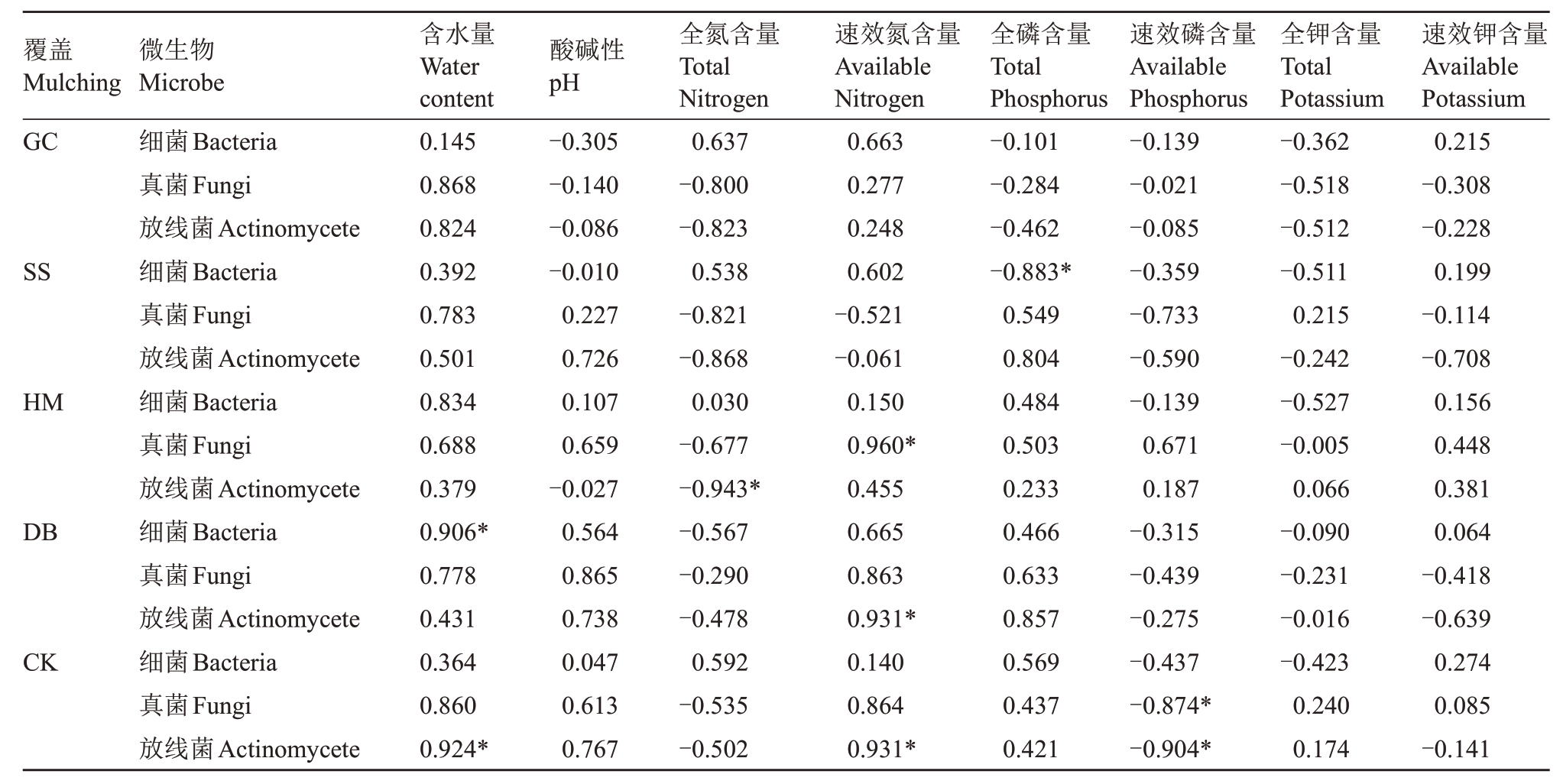黄土高原大部分地区光热资源丰富,昼夜温差大,适宜生产优质苹果,已成为全球最大的苹果集约化种植区[1]。位于黄土高原苹果优势产区的静宁县,苹果种植面积已达6.67万hm2,产量约达88万t,产值达39.6 亿元,苹果产业已成为当地农村的经济支柱[2-3]。然而,黄土高原是世界公认的严重侵蚀地区之一,黄土沉积严重,土质疏松,土壤水分和有机碳缺乏,长期的果园清耕管理模式严重制约了静宁县苹果产业的发展[4-6]。
近年来,为改善土壤结构,如免耕、轮作、植草、覆盖等保护性耕作在世界范围内得到广泛应用,尤其覆盖处理已成为提高土壤微生物活性和解决土壤质量差等问题的有效方法[7-8]。在农业生态系统中,微生物作为土壤中的一个生物参数,对土壤养分循环和质量改善具有重要作用[9]。由于微生物对环境条件和种植方式高度敏感,因此土壤的健康与土壤微生物群落结构、多样性和功能密切相关[10-11]。
然而,不同覆盖材料下土壤环境的异质性决定了土壤微生物优势群落及生物量变化的差异[8]。据报道,秸秆覆盖和园艺地布覆盖可有效提高苹果园土壤含水量和速效钾的含量,降低土壤pH 值,且植物残基的输入为土壤微生物提供栖息地和营养致使土壤微生物数量增多[12-13]。在干旱的西北地区果园,聚乙烯(PE)地膜覆盖可有效抑制土壤水分蒸发,提高土壤温度和养分含量,这种增温保墒效应促使土壤微生物增多[14-16]。砂石覆盖作为黄土高原历史悠久的特色农业技术,可以有效减少地表径流和土壤流失量,对土壤全氮、全磷等养分含量的流失具有明显的抑制作用,是西北黄土地区一种有效的水土保持技术[17]。已有研究表明,微生物丰度及群落结构与作物产量和品质存在显著正相关(p<0.05),虽然不同覆盖材料及方式对苹果园的影响研究颇多,但大多都关注覆盖处理一段时间后土壤理化性质或微生物群落变化[18-20],鲜有果园覆盖处理对各生育期土壤微生物的影响及果园理化性质和土壤微生物相关性的研究。因此,笔者在本研究中通过比较试验,探讨砂石覆盖、干草覆盖、园艺地布覆盖和PE黑膜覆盖下苹果树全生育期及0~60 cm根区土层中土壤理化性质和微生物数量的变化,分析土壤含水量、pH 和养分含量等与微生物种类及数量间的相互关系,以期为黄土高原苹果园区的管理方式提供参考。
1 材料和方法
1.1 研究区概况
研究区位于暖温带半湿润半干旱气候区的甘肃省平凉市静宁县现代苹果高新技术示范园(105°20′~106°05′E,35°01′~35°45′N),年均气温7.1 ℃,无霜期约159 d,日照时数2238 h;自然降水偏少,夏季雨水较多,冬春较少,年均降水量450.8 mm,可靠值383 mm,年蒸发量1469 mm。
1.2 试验设计
2018年2—12月,以陇东海棠为基砧、M26为中间砧的4 年生富士苹果树为供试材料,采用高纺锤形、3.5 m 行距、1.2 m 株距的矮砧密植栽植模式种植,适宜种植密度为2400 株·hm-2。在果园统一管理模式下设置干草覆盖(GC)、砂石覆盖(SS)、PE黑膜覆盖(HM)、园艺地布覆盖(DB)和清耕(CK)对照5 个处理进行行间覆盖,各覆盖厚度:干草5 cm,砂石8 cm,PE黑膜0.008 mm,地布0.12 mm,覆盖宽度为1.4 m。采用随机取样法,各处理选取3 株果树,用土钻定点采取苹果树各生育期根区土壤。取样以同株果树的树干为中心,在果树投影区域分别取东西南北4个方位,土层深度分别为0~20、>20~40、>40~60 cm的土壤,混合去杂后标记带回,用2 mm筛子过筛后保存备用。
1.3 样品测定
1.3.1 土壤理化性质的测定 土壤全氮含量测定采用半微量凯氏定氮法;土壤全磷含量的测定采用硫酸高氯酸消煮-钼锑抗混合试剂比色法;土壤全钾含量的测定采用NaOH熔融-火焰光度法[21]。土壤含水量、pH、速效氮、速效磷、速效钾含量测定参考李发康等[22]的测定方法进行。
1.3.2 土壤微生物的测定 富士苹果树根区微生物群落研究均采用培养基培养法,将新鲜土样用无菌水稀释至适宜稀释梯度和接种量,用稀释平板涂布法计数[23]。菌落数量计算公式:

1.4 数据统计与分析
采用Excel 软件记录数据,用SPSS 21 软件Duncna’s新复极差法进行方差分析。
2 结果与分析
2.1 不同覆盖处理对0~60 cm苹果树根区土壤理化性质的影响
由表1 可知,从整体看覆盖技术能够有效提高0~60 cm 土层的土壤含水量和养分含量,改善土壤酸碱度。与CK相比,4种覆盖处理均显著提高土壤含水量(p<0.05),增幅为2.6%~5.0%,不同覆盖处理对土壤含水量影响大小为:DB>SS>GC>HM>CK。与CK 相比,SS 处理使土壤pH 上升0.08,但未呈现显著差异(p>0.05),其他处理均有效降低土壤pH,其中DB 和HM 处理与CK 存在显著差异。不同覆盖材料对土壤养分含量的影响各有差异,与CK 相比,4 种覆盖处理土壤全磷含量可提高0.08~0.11 g·kg-1,GC、SS 和DB 处理均显著提高了土壤全钾含量,4 种覆盖处理土壤全氮含量虽未表现出显著差异,但GC、SS和HM处理土壤全氮含量均有提高。与CK 相比,HM 和DB 处理增加了土壤有效氮的含量,增幅为9.12~21.22 mg·kg-1。各处理对土壤速效钾和速效磷含量的影响未表现出显著性差异,但与CK 相比均有所提升,其中DB 处理可以最大限度地提升0~60 cm土壤速效钾和速效磷含量。
表1 不同覆盖处理对0~60 cm 苹果树根区土壤理化性质的影响
Table 1 Effects of different Mulching treatments on physicochemical properties of root zone soil of 0~60 cm apple trees

注:GC、SS、HM、DB、CK 分别表示覆盖为干草、砂石、PE 黑膜、园艺地布和清耕。小写字母表示不同覆盖处理在p<0.05 差异显著。下同。
Note:The distribution of GC, SS, HM, DB and CK indicates that the cover is hay, sand and gravel, PE black film, horticultural ground and clear tillage.The lowercase letters indicated that there was significant difference between different coating covers at p<0.05.The same below.
w(速效磷)Available Phosphorus/(mg·kg-1)19.05±2.81 a 22.08±7.92 a 33.73±12.48 a 38.07±14.76 a 17.84±5.18 a覆盖Mulching pH GC SS HM DB CK w(水分)Moisture content/%20.22±0.69 bc 21.29±0.86 ab 19.63±0.45 c 22.03±0.47 a 17.03±0.45 d 8.23±0.04 a 8.33±0.06 a 8.04±0.02 b 8.10±0.03 b 8.25±0.03 a w(全氮)Total Nitrogen/(g·kg-1)0.70±0.06 a 0.65±0.05 a 0.60±0.05 a 0.56±0.09 a 0.59±0.09 a w(全钾)Total Potassium/(g·kg-1)10.14±0.10 a 10.11±0.08 ab 9.04±0.10 c 9.84±0.03 b 9.10±0.11 c w(全磷)Total Phosphorus/(g·kg-1)0.72±0.04 a 0.75±0.05 a 0.70±0.08 a 0.75±0.10 a 0.64±0.04 a w(速效氮)Available Nitrogen/(mg·kg-1)69.52±7.67 ab 62.36±5.77 b 88.69±8.78 ab 100.79±12.38 a 79.57±10.97 ab w(速效钾)Available Potassium/(mg·kg-1)303.24±59.01 a 234.25±30.27 a 256.29±34.66 a 319.72±43.96 a 215.35±53.73 a
2.2 不同覆盖处理对苹果树根区土壤真菌的影响
由表2和图1可知,覆盖处理显著增加了土壤真菌数量(p<0.05)。从空间分布来看,随着土层深度的增加,土壤真菌数量逐渐减少。从时间分布来看,随生育期的推进,各土层中土壤真菌数量呈逐渐减少趋势。在0~20 cm 土层,GC 和DB 处理可显著增加土壤真菌数量,且除幼果期和果实膨大期外,其余生育期的土壤真菌数量皆大于CK;而HM处理在全生育期内土壤真菌数量皆小于CK。在>20~40 cm土层,除SS 处理下土壤真菌数量高于CK 外,其余处理下土壤真菌数量皆显著低于CK,并且HM处理在果树全生育期内土壤真菌数量均小于CK;而对>40~60 cm 土层,除HM 处理下土壤真菌数量小于CK外,其余处理皆显著高于CK;从全生育期看,除幼果期和果实膨大期外,各处理在其余生育期土壤真菌数量大于CK。从0~60 cm土层看,GC和DB处理可显著提高土壤真菌数量,分别比CK 处理提高47.91%和11.10%。

图1 不同覆盖处理对各生育期0~60 cm 土层根区土壤真菌数量的影响
Fig.1 Effects of different mulching treatments on the number of root zone soil fungi in 0-60 cm soil layer at different growth period
I.休眠期;II.盛花期;III.幼果期;IV.果实膨大期;V.果实成熟期。下同。
I.Dormancy stage;II.Full flowering;III.Fruit formation stage;IV.Fruit expansion stage;V.Fruit ripening stage.The same below.
表2 不同覆盖处理对各土层根区土壤真菌数量的影响
Table 2 Effects of different mulching treatments on fungi quantity in root zone soil of different soil layers(×105 CFU· g-1)

土层Soil horizon/cm 0~20>20~40>40~60 0~60 GC 53.64±0.67 a 19.64±0.56 b 11.62±0.54 a 80.51±0.50 a SS 15.30±1.13 e 26.37±0.55 a 6.51±0.50 b 40.62±0.54 d HM 19.38±0.54 d 5.54±0.50 d 5.40±0.53 c 30.00±1.01 e DB 30.46±0.51 b 17.51±0.50 c 12.49±0.50 a 60.47±0.50 b CK 23.45±0.51 c 25.53±0.50 a 5.45±0.51 c 54.43±0.51 c
2.3 不同覆盖处理对苹果树根区土壤细菌的影响
从空间分布来看,GC 处理在0~20 cm 和>40~60 cm土层的细菌数量显著大于CK,而DB处理在各土层的土壤细菌数量均显著小于CK(p<0.05)。在0~60 cm土层,除SS处理外,其余处理土壤细菌数量均显著小于CK,且HM 和DB 处理的结果和土壤真菌数量的变化趋势一致(表3)。从时间分布来看,各处理在果实膨大期细菌数量出现最大值,在果实成熟期出现最小值(图2)。较CK而言,SS处理可增加土壤细菌数量,但无显著差异(p>0.05),而GC、HM和DB处理可显著降低27.51%~61.81%的土壤细菌数量。

图2 不同覆盖处理对各生育期0~60 cm 土层根区土壤细菌数量的影响
Fig.2 Effects of different mulching treatments on the number of root zone soil bacteria in 0~60 cm soil layer at different growth period
表3 不同覆盖处理对各土层根区土壤细菌数量的影响
Table 3 Effects of different mulching treatments on bacteria quantity in root zone soil of different soil layers
(×1010 CFU· g-1)

土层Soil horizon/cm 0~20>20~40>40~60 0~60 GC 31.69±0.60 a 7.71±0.26 e 29.50±0.50 a 60.31±0.54 b SS 29.58±0.52 c 40.55±0.51 a 22.57±0.51 c 91.03±0.21 a HM 13.56±0.51 e 13.37±0.55 d 8.49±0.50 e 31.77±0.32 d DB 22.10±0.10 d 20.47±0.50 c 17.41±0.52 d 53.30±0.58 c CK 30.60±0.53 b 34.52±0.50 b 24.42±0.52 b 83.20±0.56 a
2.4 不同覆盖处理对苹果树根区土壤放线菌的影响
覆盖处理可不同程度地增加土壤放线菌数量。与CK 相比,GC 和HM 处理可显著提高0~60 cm 土壤放线菌数量(p<0.05),分别增加了96.07%和29.59%,而DB 处理仅显著增加了>40~60 cm 土层的放线菌数量(表4)。从时间分布来看,GC 和HM处理从休眠期到果实成熟期土壤放线菌数量表现为先降低再升高、又降低再升高的趋势;而SS和DB处理则表现为持续降低的趋势(图3)。

图3 不同覆盖处理对各生育期0~60 cm 土层根区土壤放线菌数量的影响
Fig.3 Effects of different mulching treatments on the number of root zone soil actinobacteria in 0~60 cm soil layer at different growth period
表4 不同覆盖处理对各土层根区土壤放线菌数量的影响
Table 4 Effects of different mulching treatments on actinobacteria quantity in root zone soil of different soil layers(×106 CFU· g-1)

土层Soil horizon/cm 0~20>20~40>40~60 0~60 GC 21.83±0.76 a 12.52±0.50 a 3.43±0.52 b 38.43±0.51 a SS 4.55±0.51 e 8.43±0.52 b 4.43±0.51 a 17.40±0.53 e HM 14.56±0.51 b 6.00±1.00 d 4.50±0.50 a 25.40±0.53 b DB 6.37±0.55 d 6.65±0.56 cd 5.39±0.54 a 18.40±0.53 d CK 9.48±0.50 c 7.41±0.52 bc 3.35±0.56 b 19.60±0.52 c
2.5 土壤理化性质与土壤微生物数量的相关性分析
由表5可知,各处理土壤微生物数量的变化与土壤含水量呈正相关,DB 处理细菌数量和CK 处理放线菌数量与土壤含水量呈显著正相关(p<0.05),其他处理均不显著。GC 处理下,土壤微生物数量与土壤pH、全磷、速效磷和全钾含量呈负相关,但未表现出显著性(p>0.05)。SS处理下的土壤细菌数量与土壤全磷含量呈显著负相关;HM处理下的土壤真菌数量与土壤速效氮含量呈显著正相关,放线菌数量与土壤全氮含量呈显著负相关;DB处理的土壤放线菌数量与速效氮含量呈显著正相关;CK 处理的放线菌数量与速效氮含量呈显著正相关,真菌和放线菌数量与速效磷含量呈显著负相关。
表5 不同覆盖处理下土壤理化性质与土壤微生物数量的相关性分析
Table 5 Correlation coefficients between soil physical and chemical properties and soil microbial population under different mulching treatments

注:*表示在p<0.05 水平上显著相关。
Note:*indicates significant correlation at p<0.05.
覆盖Mulching GC SS HM DB CK速效钾含量Available Potassium 0.215-0.308-0.228 0.199-0.114-0.708 0.156 0.448 0.381 0.064-0.418-0.639 0.274 0.085-0.141微生物Microbe细菌Bacteria真菌Fungi放线菌Actinomycete细菌Bacteria真菌Fungi放线菌Actinomycete细菌Bacteria真菌Fungi放线菌Actinomycete细菌Bacteria真菌Fungi放线菌Actinomycete细菌Bacteria真菌Fungi放线菌Actinomycete含水量Water content 0.145 0.868 0.824 0.392 0.783 0.501 0.834 0.688 0.379 0.906*0.778 0.431 0.364 0.860 0.924*酸碱性pH-0.305-0.140-0.086-0.010 0.227 0.726 0.107 0.659-0.027 0.564 0.865 0.738 0.047 0.613 0.767全氮含量Total Nitrogen 0.637-0.800-0.823 0.538-0.821-0.868 0.030-0.677-0.943*-0.567-0.290-0.478 0.592-0.535-0.502速效氮含量Available Nitrogen 0.663 0.277 0.248 0.602-0.521-0.061 0.150 0.960*0.455 0.665 0.863 0.931*0.140 0.864 0.931*全磷含量Total Phosphorus-0.101-0.284-0.462-0.883*0.549 0.804 0.484 0.503 0.233 0.466 0.633 0.857 0.569 0.437 0.421速效磷含量Available Phosphorus-0.139-0.021-0.085-0.359-0.733-0.590-0.139 0.671 0.187-0.315-0.439-0.275-0.437-0.874*-0.904*全钾含量Total Potassium-0.362-0.518-0.512-0.511 0.215-0.242-0.527-0.005 0.066-0.090-0.231-0.016-0.423 0.240 0.174
3 讨 论
黄土高原是我国水土流失最为严重的地区之一,土壤为黄绵土,结构疏松,加之气候干燥,降水稀少,果园清耕模式不利于苹果园的可持续发展,而地面覆盖作为一种改善土壤质量、提高作物产量的措施,在国内外得到广泛应用[24]。笔者在本研究中发现,对果园进行覆干草、覆砂石、覆PE 黑膜和覆园艺地布4 种处理后,均使土壤微环境产生一定的变化。覆盖对土壤水分的影响取决于降水和气候因子,通过控制地表蒸发速率对土壤水分状况有良好的影响[25]。4 种覆盖处理比清耕显著提高2.6%~5.0%的土壤含水量,其中园艺地布覆盖处理最为明显,这是因为地布作为新型覆盖材料具有较强的渗水性,并且可有效地降低水分蒸发[15]。碱性土壤对植物的生长和矿物质的吸收具有抑制作用[26],而覆盖PE黑膜和园艺地布可有效降低土壤pH,砂石覆盖反而加重了土壤碱化。土壤养分作为作物生长发育的物质基础,也是土壤肥力的重要指标之一[27]。较清耕处理而言,覆盖处理可有效提高苹果园0~60 cm 土层土壤全素含量和速效养分含量,尤其是磷素含量,4种覆盖处理下均表现为增高。虽然覆盖处理对土壤养分含量总体表现为提高趋势,但仍存在例外,其中园艺地布覆盖降低了土壤全氮含量,PE黑膜覆盖降低了土壤全钾含量,干草覆盖和砂石覆盖则降低了土壤速效氮含量,这与Gan等[28]的研究结果一致,这主要是因为土壤养分的变化受多因素影响,包括初始土壤养分水平、微生物群落和活性、有效土壤水分等,而不单单是由覆盖所致。
微生物群落不仅是生态系统健康和恢复水平的指标,而且可以通过调控微生物群落来促进退化生态系统的恢复[29]。土壤微生物作为土壤生态系统的主要驱动者,在调节养分循环、分解有机质、影响土壤结构、抑制植物病害和提高植物产量方面有着重要作用[30]。本研究表明,土壤中细菌数量远大于真菌,4种覆盖均增加了土壤表层微生物的数量,且随着土层深度的增加,土壤微生物数量逐渐减少,其中干草覆盖显著增加了0~60 cm土层土壤真菌和放线菌数量,土壤细菌数量相比清耕处理反而减少,这可能由于真菌善于分解有机物质,新鲜有机质的输入可能优先刺激土壤真菌的生长和繁殖[13]。放线菌作为一种可以产生分解木质素酶的腐生菌类,可大量分解土壤中的植物有机残体,因此干草覆盖后土壤中的放线菌数量显著增加[31]。与清耕相比,园艺地布覆盖则只增加了土壤真菌数量,细菌和放线菌数量均有所降低,这与王元基[13]和薛晓敏等[12]的研究结果相反,可能是因为土壤真菌数量的大幅提高抑制了细菌和放线菌的生长,但具体原因还需进一步研究。除放线菌数量变化外,砂石覆盖对土壤微生物数量的改变与前2 种处理则相反,可能与砂石覆盖增加土壤碱性有关,并且较其他覆盖,砂石覆盖对土壤性状的影响较弱,在不同覆盖模式下,土壤真菌的适应性和功能多样性略强于细菌,在微碱环境中,细菌生长比真菌生长较旺盛,因此砂石覆盖与其他覆盖处理对微生物数量的影响产生不同结果[8,32]。本研究还发现,覆盖处理后,随着果树发育阶段的进行,土壤真菌数量逐渐降低,而土壤细菌数量在果实膨大期达到最大值,土壤放线菌数量则在干草覆盖和PE黑膜覆盖中先降低再升高再降低,砂石覆盖和园艺地布覆盖的变化趋势与土壤真菌数量变化趋势一致。与沈鹏飞[31]的研究相类似,这主要是因为覆盖过程逐渐增加了有机质,为微生物提供更多养料,从而促进微生物的活动,且随着覆盖时间的延长,土壤酶活性、微生物数量的增加,使得微生物数量达到饱和状态,因此微生物数量又会呈现降低趋势[33]。
土壤是土壤微生物的一个高度异质性的环境,土壤理化性质对土壤微生物的生物量具有重要影响[29,34]。本研究中各覆盖处理下,土壤含水量与土壤微生物数量均呈正相关,这可能是因为覆盖处理可以抑制杂草生长,减少养分竞争,可以有效贮存水分,为微生物的生长繁殖提供相对稳定的土壤环境[31]。除干草覆盖下的微生物和PE 黑膜覆盖下的土壤放线菌外,土壤微生物数量变化与土壤pH也呈正相关。而土壤全钾、速效钾和速效磷含量与土壤微生物数量呈负相关(除SS处理的细菌数量和HM处理),这可能与黄土高原苹果园磷、钾含量过剩有关[35]。土壤氮素的形成和转化与土壤微生物氮素生理群密切相关[36],因此,除砂石覆盖的土壤真菌与放线菌数量与土壤速效氮含量呈负相关外,其余覆盖处理的微生物量皆与其呈正相关,可能是因为覆盖增加了氮素的积累,参与氮循环的微生物增多,但具体原因还得进一步试验验证[5]。此外,本试验只是对不同覆盖处理的土壤微生物数量进行了调查,微生物种类的变化是否与覆盖处理的不同而有所差异还需进一步试验分析,并且只对果园进行了为期一年的覆盖处理,覆盖时间的长短以及地面覆盖物的薄厚对土壤微生物产生何种影响还需进一步探究。
4 结 论
与清耕(CK)相比,干草、砂石、PE 黑膜和园艺地布覆盖均可有效改善0~60 cm 的土壤理化性质。其中干草覆盖和园艺地布覆盖处理可显著提高土壤含水量,改善养分条件,提高土壤真菌和放线菌数量,可优先作为黄土高原苹果园区土地管理的方式。
[1] WANG S F,AN J,ZHAO X N,GAO X D,WU P T,HUO G P,ROBINSON B H.Age-and climate-related water use patterns of apple trees on China’s Loess Plateau[J/OL].Journal of Hydrology,2020,582:124462.DOI:10.1016/j.jhydrol.2019.124462.
[2] 周江涛,赵德英,陈艳辉,康国栋,程存刚.中国苹果产区变动分析[J].果树学报,2021,38(3):372-384.ZHOU Jiangtao,ZHAO Deying,CHEN Yanhui,KANG Guodong,CHENG Cungang.Analysis of apple producing changes in China[J]. Journal of Fruit Science,2021,38(3):372-384.
[3] 王田利. 静宁县苹果区域品牌化建设的成就及主要做法[J].果树资源学报,2021,2(6):75-77.WANG Tianli.Achievements and main method of apple regional brand construction in Jingning county[J]. Journal of Fruit Resources,2021,2(6):75-77.
[4] ZHENG W,WEN M J,ZHAO Z Y,LIU J,WANG Z H,ZHAI B N,LI Z Y. Black plastic mulch combined with summer cover crop increases the yield and water use efficiency of apple tree on the rainfed Loess Plateau[J/OL]. PLoS One,2017,12(9):e0185705.DOI:10.1371/journal.pone.0185705.
[5] YANG M,WANG S F,ZHAO X N,GAO X D,LIU S. Soil properties of apple orchards on China's Loess Plateau[J/OL].Science of the Total Environment,2020,723:138041. DOI:10.1016/j.scitotenv.2020.138041.
[6] WANG Y J,HUANG Q Q,GAO H,ZHANG R Q,YANG L,GUO Y R,LI H K,AWASTHI M K. Long-term cover crops improved soil phosphorus availability in a rain-fed apple orchard[J/OL]. Chemosphere,2021,275:130093. DOI:10.1016/j.chemosphere.2021.130093.
[7] WANG Y J,HUANG Q Q,LIU C,DING Y Y,LIU L,TIAN Y L,WU X P,LI H K,AWASTHI M K,ZHAO Z Y. Mulching practices alter soil microbial functional diversity and benefit to soil quality in orchards on the Loess Plateau[J/OL]. Journal of Environmental Management,2020,271:110985. DOI:10.1016/j.jenvman.2020.110985.
[8] WANG Y J,LI L,LUO Y,AWASTHI M K,YANG J F,DUAN Y M,LI H K,ZHAO Z Y.Mulching practices alter the bacterialfungal community and network in favor of soil quality in a semiarid orchard system[J/OL]. Science of the Total Environment,2020,725:138527.DOI:10.1016/j.scitotenv.2020.138527.
[9] LIU C,LI L L,XIE J H,COULTER J A,ZHANG R Z,LUO Z Z,CAI L Q,WANG L L,GOPALAKRISHNAN S. Soil bacterial diversity and potential functions are regulated by long-term conservation tillage and straw mulching[J/OL]. Microorganisms,2020,8(6):836.DOI:10.3390/microorganisms8060836.
[10] CHAI X,YANG Y,WANG X,HAO P,WANG L,WU T,ZHANG X,XU X,HAN Z,WANG Y. Spatial variation of the soil bacterial community in major apple producing regions of China[J]. Journal Applied Microbiology,2021,130(4):1294-1306.
[11] MAU R L,LIU C M,AZIZ M,SCHWARTZ E,DIJKSTRA P,MARKS J C,PRICE L B,KEIM P,HUNGATE B A. Linking soil bacterial biodiversity and soil carbon stability[J].Multidisciplinary Journal of Microbial Ecology,2015,9(6):1477-1480.
[12] 薛晓敏,王来平,韩雪平,陈汝,王金政.不同树盘覆盖对矮砧苹果园土壤微生物群落结构和多样性的影响[J].生态学报,2021,41(4):1528-1536.XUE Xiaomin,WANG Laiping,HAN Xueping,CHEN Ru,WANG Jinzheng. Effects of different tree disk mulching on soil microbial community structure and diversity in dwarfing rootstock apple orchard[J]. Acta Ecologica Sinica,2021,41(4):1528-1536.
[13] 王元基.覆盖模式下黄土高原苹果园土壤质量提升效应的微生物学机制[D].杨凌:西北农林科技大学,2020.WANG Yuanji. The microbiological mechanism of soil quality improvement effect under mulching pattern in apple orchard on Loess Plateau[D].Yangling:Northwest A&F University,2020.
[14] CHEN Y X,WEN X X,SUN Y L,ZHANG J H,WU W,LIAO Y C. Mulching practices altered soil bacterial community structure and improved orchard productivity and apple quality after five growing seasons[J]. Scientia Horticulturae,2014,172:248-257.
[15] 曹刚,毕淑海,赵明新,曹素芳,王玮,牛济军,李红旭.干旱区梨园不同覆盖条件下土壤环境因子综合性评价研究[J].干旱区地理,2022,45(3):890-900.CAO Gang,BI Shuhai,ZHAO Mingxin,CAO Sufang,WANG Wei,NIU Jijun,LI Hongxu. Comprehensive evaluation of soil environmental factors under different mulching conditions in pear orchard in arid region[J]. Arid Land Geography:2022,45(3):890-900.
[16] 陈月星,温晓霞,孙瑜琳,张俊丽,林晓丽,廖允成.地表覆盖对渭北旱作苹果园土壤细菌群落结构及多样性的影响[J].微生物学报,2015,55(7):892-904.CHEN Yuexing,WEN Xiaoxia,SUN Yulin,ZHANG Junli,LIN Xiaoli,LIAO Yuncheng. Effect of ground mulch managements on soil bacterial community structure and diversity in the non-irrigated apple orchard in Weibei Loess Plateau[J].Acta Microbiologica Sinica,2015,55(7):892-904.
[17] QIU Y,WANG X P,XIE Z K,WANG Y J.Effects of gravel-sand mulch on the runoff,erosion,and nutrient losses in the Loess Plateau of north-western China under simulated rainfall[J]. Soil and Water Research,2020,16(1):22-28.
[18] 尹晓宁,刘兴禄,董铁,牛军强,孙文泰,马明.苹果园不同覆盖材料对土壤与近地微域环境及树体生长发育的影响[J].中国生态农业学报,2018,26(1):83-95.YIN Xiaoning,LIU Xinglu,DONG Tie,NIU Junqiang,SUN Wentai,MA Ming. Effects of different mulching materials on soil and near-surface environment and of apple orchard tree growth[J]. Chinese Journal of Eco-Agriculture,2018,26(1):83-95.
[19] 屠娟丽,费伟英,张平.秸秆生物炭用量对马铃薯品质及土壤生化性质的影响[J].中国瓜菜,2019,32(12):41-44.TU Juanli,FEI Weiying,ZHANG Ping. Effect of the amount of biochar on potato quality and soil biochemical properties[J].China Cucurbits and Vegetables,2019,32(12):41-44.
[20] 陈静,胡云,崔文芳.秸秆还田对温室黄瓜根际土壤代谢和菌群的影响[J].中国瓜菜,2020,33(7):14-18.CHEN Jing,HU Yun,CUI Wenfang. Effects of different modes of straw returned soil on metabolism and flora of rhizosphere soil of greenhouse cucumber[J]. China Cucurbits and Vegetables,2020,33(7):14-18.
[21] 鲁如坤.土壤农业化学分析方法[M].北京:中国农业科技出版社,1999:12-292.LU Rukun. Soil agricultural chemical analysis method[M]. Beijing:China Agricultural Science and Technology Press,1999:12-292.
[22] 李发康,谢玉琴,薛应钰,李龙,李小伟.苹果树根域土壤理化性质对园艺地布覆盖的响应[J].干旱地区农业研究,2020,38(5):123-129.LI Fakang,XIE Yuqin,XUE Yingyu,LI Long,LI Xiaowei. Response of physical and chemical properties of soil in apple rootzone to black ground fabric mulching[J]. Agricultural Research in the Arid Areas,2020,38(5):123-129.
[23] 王倩,安贵阳,李世芳,曹欣冉.不同覆盖模式对旱地苹果园土壤养分、微生物和酶活性的影响[J]. 西北农业学报,2015,24(7):69-74.WANG Qian,AN Guiyang,LI Shifang,CAO Xinran.Soil nutrients,enzyme activities and microbes in non-irrigation apple orchard under different mulching managements[J]. Acta Agriculturae Boreali-occidentalis Sinica,2015,24(7):69-74.
[24] 张越阳.渭北旱地矮化苹果园覆盖措施蓄水保墒效应研究[D].杨凌:西北农林科技大学,2021.ZHANG Yueyang.Study on water storage and moisture conserving effect of covering measures for dwarfing apple orchard in Weibei Dryland[D].Yangling:Northwest A&F University,2021.
[25] KADER M A,SENGE M,MOJID M A,ITO K.Recent advances in mulching materials and methods for modifying soil environment[J].Soil and Tillage Research,2017,168:155-166.
[26] 张丽丽,史庆华,巩彪.中、碱性土壤条件下黄腐酸与磷肥配施对番茄生育和磷素利用率的影响[J].中国农业科学,2020,53(17):3567-3575.ZHANG Lili,SHI Qinghua,GONG Biao. Application of fulvic acid and phosphorus fertilizer on tomato growth,development,and phsphorus utilization in neutral and alkaline Soil[J]. Scientia Agricultura Sinica,2020,53(17):3567-3575.
[27] 潘占东,马倩倩,陈晓龙,蔡立群,蔡雪梅,董博,武均,张仁陟.添加生物质炭对黄土高原旱作农田土壤养分、腐殖质及其组分的影响[J].草业学报,2022,31(2):14-24.PAN Zhandong,MA Qianqian,CHEN Xiaolong,CAI Liqun,CAI Xuemei,DONG Bo,WU Jun,ZHANG Renzhi. Effects of biochar addition on nutrient levels and humus and its components in dry farmland soils on the Loess Plateau[J].Acta Prataculturae Sinica,2022,31(2):14-24.
[28] GAN Y T,SIDDIQUE K H M,TURNER N C,LI X G,NIU J Y,YANG C,LIU L P,CHAI Q. Ridge-furrow mulching systems:An innovative technique for boosting crop productivity in semiarid rain- fed environments[J]. Advances in Agronomy,2013,118:429-476.
[29] OKSANA C,GERLINDE B D D,MARTINE V D P.Soil microbiota as game-changers in restoration of degraded lands[J/OL].Science,2022,375(6584):eabe0725.https://doi.org/10.1126/science.abe0725
[30] GARBEVA P,VAN VEEN J A,VAN ELSAS J D.Microbial diversity in soil:selection microbial populations by plant and soil type and implications for disease suppressiveness[J].Annual Review of Phytopathology,2004,42(1):243-270.
[31] 沈鹏飞.不同覆盖措施对渭北苹果园土壤理化性质及微生物群落结构的影响[D].杨凌:西北农林科技大学,2019.SHEN Pengfei. Effects of different mulching measures on soil physical and chemical properties,microbial community characteristics in Weibei apple orchard[D]. Yangling:Northwest A&F University,2019.
[32] 李青梅,张玲玲,赵建宁,张艳军,刘红梅,王华玲,王慧,杨殿林,张凡,翁昌明.覆盖作物不同利用方式对猕猴桃园土壤微生物群落结构的影响[J].农业资源与环境学报,2020,37(3):319-325.LI Qingmei,ZHANG Lingling,ZHAO Jianning,ZHANG Yanjun,LIU Hongmei,WANG Hualing,WANG Hui,YANG Dianlin,ZHANG Fan,WENG Changming. Effects of different cover crop treatments on soil microbial community composition in kiwifruit orchard[J]. Journal of Agricultural Resources and Environment,2020,37(3):319-325.
[33] 孙文泰,董铁,刘兴禄,尹晓宁,牛军强,马明.陇东旱塬地表覆盖方式对苹果生育后期叶片质量及根际土壤微环境的影响[J].干旱地区农业研究,2019,37(1):95-101.SUN Wentai,DONG Tie,LIU Xinglu,YIN Xiaoning,NIU Junqiang,MA Ming. Effects of ground mulching on leaf quality in late growth stage and rhizosphere environment in the dryland of eastern Gansu province[J].Agricultural Research in the Arid Areas,2019,37(1):95-101.
[34] 吴勇,刘晓静,童长春,赵雅姣.施氮对西北荒漠灌区紫花苜蓿土壤理化性质及微生物数量的影响[J].草原与草坪,2020,40(6):58-64.WU Yong,LIU Xiaojing,TONG Changchun,ZHAO Yajiao. Effect of nitrogen application on soil physicochemical property and microbial quantity of alfalfa in desert irrigation area of Northwest China[J].Grassland and Turf,2020,40(6):58-64.
[35] 陈翠霞,刘占军,陈竹君,霍百全,周建斌.黄土高原新老苹果产区施肥现状及土壤肥力状况评价[J]. 土壤通报,2018,49(5):1144-1149.CHEN Cuixia,LIU Zhanjun,CHEN Zhujun,HUO Baiquan,ZHOU Jianbin. Evaluating the situation of fertilization and soil fertility in new and old apple orchards of the Loess Plateau[J].Chinese Journal of Soil Science,2018,49(5):1144-1149.
[36] 张慧敏,李希来,杨帆.增温和氮添加对高寒草甸土壤微生物氮素生理群的影响[J].草地学报,2020,28(3):606-612.ZHANG Huimin,LI Xilai,YANG Fan. Effects of warming and nitrogen fertilization on soil microbial nitrogen physiology groups in Alpine Meadow[J].Acta Agrestia Sinica,2020,28(3):606-612.